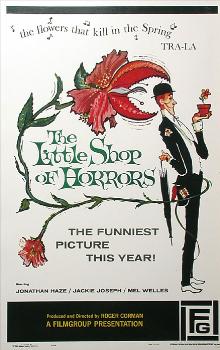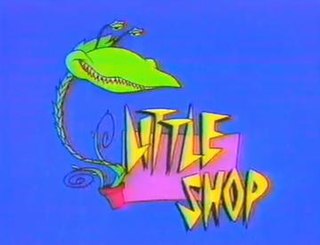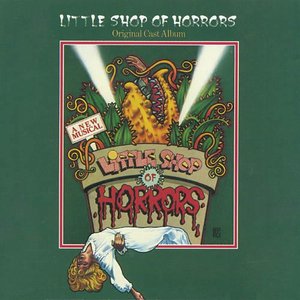
Frank Oz is an American actor, puppeteer, and filmmaker. He is best known for his involvement with Jim Henson and the Muppets, as well as his directorial work in feature films and theater including Star Wars.
Martin P. Robinson is an American puppeteer who works for the Jim Henson Company. He is best known for his work on Sesame Street, having performed the characters of Telly Monster, Mr. Snuffleupagus, Oscar the Grouch's pet worm Slimey, Oscar's niece Irvine, Buster the Horse, and Shelley the Turtle for 40 years. He also designed, built, and performed the Audrey II puppets for Little Shop of Horrors. Robinson performed the characters Riff the Cat and Clef the dad on Allegra's Window, and was an animatronic puppeteer for Leonardo in Teenage Mutant Ninja Turtles. He was responsible for training the puppeteers on Sesame Tree, and performed the Cat in the Hat in the second season of The Wubbulous World of Dr. Seuss.

The Little Shop of Horrors is a 1960 American horror comedy film directed by Roger Corman. Written by Charles B. Griffith, the film is a farce about a florist's assistant who cultivates a plant that feeds on human blood. The film's concept may have been inspired by "Green Thoughts", a 1932 story by John Collier about a man-eating plant. Hollywood writer Dennis McDougal suggests that Griffith may have been influenced by Arthur C. Clarke's 1956 science fiction short story "The Reluctant Orchid".

Howard Elliott Ashman was an American playwright, lyricist and stage director. He is most widely known for his work on feature films for Walt Disney Animation Studios, for which Ashman wrote the lyrics and Alan Menken composed the music. Ashman has been credited as being a main driving force behind the Disney Renaissance. His work included songs for Little Shop of Horrors, The Little Mermaid, Beauty and the Beast, and Aladdin. Tim Rice took over to write the rest of the songs for the latter film after Ashman's death in 1991.

Alan Irwin Menken is an American composer, pianist, music director, and record producer, best known for his scores and songs for films produced by Walt Disney Animation Studios. Menken's music for The Little Mermaid (1989), Beauty and the Beast (1991), Aladdin (1992), and Pocahontas (1995) has each won him two Academy Awards. He also composed the scores and songs for Little Shop of Horrors (1986), Newsies (1992), The Hunchback of Notre Dame (1996), Hercules (1997), Home on the Range (2004), Enchanted (2007), Tangled (2010), and Disenchanted (2022), among others. His accolades include winning eight Academy Awards — becoming the second most prolific Oscar winner in the music categories after Alfred Newman, a Tony Award, eleven Grammy Awards, seven Golden Globe Awards, and a Daytime Emmy Award. Menken is one of eighteen people to have won an Emmy, a Grammy, an Oscar and a Tony. He is one of two people to have won a Razzie, an Emmy, a Grammy, an Oscar, and a Tony ("REGOT").
Brian Henson is an American puppeteer, director, producer, voice actor and the chairman of The Jim Henson Company. He is the son of puppeteers Jim and Jane Henson.

Little Shop is a 1991 animated fantasy comedy television series that aired on Saturday mornings on the Fox Kids TV network, about a teenager and a giant talking plant. Little Shop was based on the 1960 Roger Corman film The Little Shop of Horrors; Corman served as a consultant. The concept of the adaptation is credited to Ellen Levy and Mark Edward Edens, and the series was produced by Tom Tataranowicz. The horror elements in previous versions of the story, in which characters are eaten by the plant, are toned down for children in this series.

Ellen Greene is an American actress and singer. She has had a long and varied career as a singer, particularly in cabaret, as an actress and singer in numerous stage productions, particularly musical theatre, as well as having performed in many films and television series. Her best-known roles are as Audrey in the original stage play and movie adaptation of Little Shop of Horrors, and as Vivian Charles in the ABC series Pushing Daisies.

Mel Welles was an American film actor and director. His best-remembered role may be that of hapless flower shop owner Gravis Mushnick in the 1960 low-budget Roger Corman dark comedy, The Little Shop of Horrors.

Ken Page is an American actor and singer. Page created the role of "Ken" in the original Broadway production of Ain't Misbehavin', and played the role of "Old Deuteronomy" in both the original Broadway and filmed stage productions of Cats. Page is also known as the voice of Oogie Boogie in The Nightmare Before Christmas franchise.

Little Shop of Horrors is a horror comedy rock musical with music by Alan Menken and lyrics and a book by Howard Ashman. The story follows a hapless florist shop worker who raises a plant that feeds on human blood and flesh. The musical is loosely based on the low-budget 1960 black comedy film The Little Shop of Horrors. The music, composed by Menken in the style of early 1960s rock and roll, doo-wop and early Motown, includes several well-known tunes, including the title song, "Skid Row (Downtown)", "Somewhere That's Green", and "Suddenly, Seymour".

Stuart Zagnit is an American voice, film and television actor. He has worked in Broadway, off-Broadway, regional and national tours, television, films, commercials, and voice-overs. Zagnit has worked as a voice actor for 4Kids Entertainment, DuArt Film and Video, and TAJ Productions.

Charles Byron Griffith was an American screenwriter, actor and film director, son of Donna Dameral, radio star of Myrt and Marge, along with Charles' grandmother, Myrtle Vail, and was best known for writing Roger Corman productions such as A Bucket of Blood (1959), The Little Shop of Horrors (1960), and Death Race 2000 (1975).

Lee Wilkof has spent decades as one of the stage and screen's most prolific character actors. He has appeared in over 125 films and television roles since 1973, 10 Broadway productions, and resident and regional theaters throughout the United States.
Mak Wilson is a now retired English puppeteer, writer, CG animation director, and mocap artist. He is also known as Mac Wilson and Malcolm Wilson.

Mike Quinn is an English puppeteer, animator, actor, director, producer, voice-over artist, puppet builder, composer and mentor. He is also known as Mike Quinby, Michael E. Quinn, and Michael Quinn.

David Alan Barclay is a British puppeteer who had worked on some projects of The Jim Henson Company. He has been at the cutting edge of animatronic puppetry since 1979. Barclay, who hails from London, is a Master Puppeteer, Animatronic Designer and Supervisor, a CG key frame Animator, and Director and Producer of animatronic and animation projects for film and television.
Angie Passmore is a British puppeteer and actress who has worked on Spitting Image and in various productions for The Jim Henson Company including The Muppets, Fraggle Rock, Labyrinth (1986) and performed as the title character in Jim Henson's Mother Goose Stories. She also puppeteered for Doctor Who (1978) and in the film Little Shop of Horrors (1986) which was directed by Frank Oz.
"Mean Green Mother from Outer Space" is a song from the 1986 American horror comedy musical film Little Shop of Horrors, an adaptation of the stage musical of the same name, which is itself an adaptation of a 1960 film of the same name. Written by the musical's creators, lyricist and book writer Howard Ashman and composer Alan Menken, the song is performed in the film by Audrey II, a sentient, carnivorous, alien plant that feeds on human blood.















